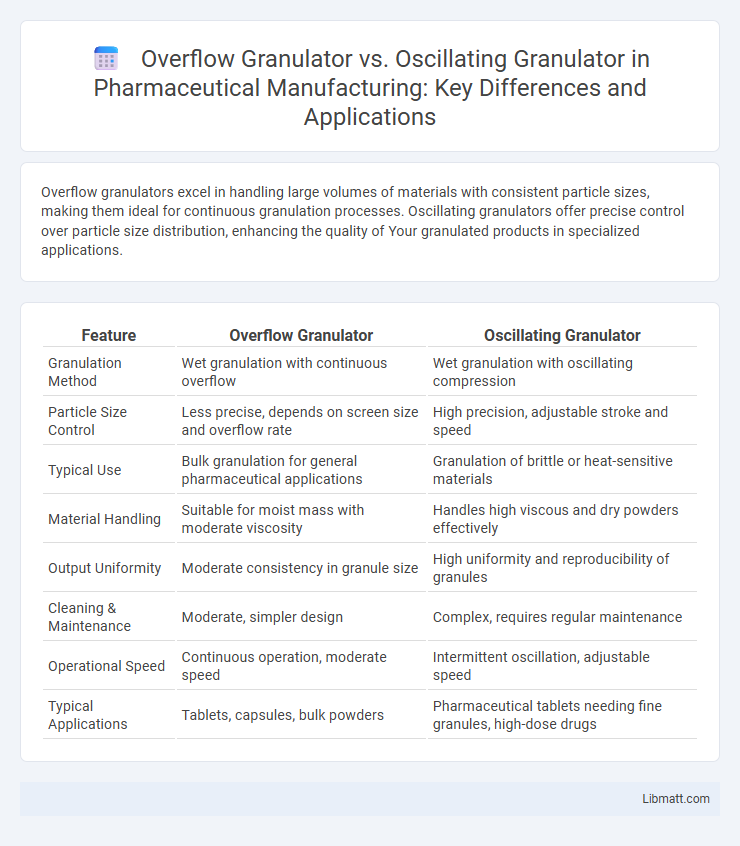Overflow granulators excel in handling large volumes of materials with consistent particle sizes, making them ideal for continuous granulation processes. Oscillating granulators offer precise control over particle size distribution, enhancing the quality of Your granulated products in specialized applications.
Table of Comparison
| Feature | Overflow Granulator | Oscillating Granulator |
|---|---|---|
| Granulation Method | Wet granulation with continuous overflow | Wet granulation with oscillating compression |
| Particle Size Control | Less precise, depends on screen size and overflow rate | High precision, adjustable stroke and speed |
| Typical Use | Bulk granulation for general pharmaceutical applications | Granulation of brittle or heat-sensitive materials |
| Material Handling | Suitable for moist mass with moderate viscosity | Handles high viscous and dry powders effectively |
| Output Uniformity | Moderate consistency in granule size | High uniformity and reproducibility of granules |
| Cleaning & Maintenance | Moderate, simpler design | Complex, requires regular maintenance |
| Operational Speed | Continuous operation, moderate speed | Intermittent oscillation, adjustable speed |
| Typical Applications | Tablets, capsules, bulk powders | Pharmaceutical tablets needing fine granules, high-dose drugs |
Introduction to Granulation Technologies
Overflow granulators excel in producing uniform granule sizes by using a continuous overflow mechanism, making them ideal for pharmaceuticals requiring consistent particle distribution. Oscillating granulators, featuring a back-and-forth blade motion, efficiently handle granular material with varying moisture content and offer precise control over particle size. Your choice between these technologies depends on the desired granule uniformity, production volume, and material characteristics.
Overview of Overflow Granulators
Overflow granulators operate by allowing granules to flow over a perforated screen, using a rotor to break down materials into uniform particles ideal for recycling plastics. This method produces consistent granule sizes with efficient throughput, minimizing material degradation and energy consumption. Choosing an overflow granulator improves Your recycling process by enhancing granule quality and operational efficiency compared to oscillating granulators.
Overview of Oscillating Granulators
Oscillating granulators operate by using a high-speed oscillating blade to cut materials into uniform granules, optimizing particle size for various industrial applications. Your choice of an oscillating granulator ensures precise granule size control, increased production efficiency, and versatility in processing plastic, rubber, and other materials. Compared to overflow granulators, oscillating granulators typically offer quieter operation and finer granulation suited for delicate or complex scrap materials.
Working Principles: Overflow vs Oscillating Granulators
Overflow granulators operate by allowing smaller particles to flow over a perforated screen while larger granules remain for further size reduction, relying on continuous material circulation for precise granule sizing. Oscillating granulators utilize a swinging blade motion combined with a stationary sieve to achieve efficient granule formation, producing uniform particle sizes through controlled shearing and cutting actions. The key difference lies in overflow granulators emphasizing material flow and circulation, whereas oscillating granulators focus on blade movement and mechanical oscillation for granulation.
Key Differences Between Overflow and Oscillating Granulators
Overflow granulators feature a patented rotor design that promotes low power consumption and minimal noise, making them ideal for reprocessing plastic waste with consistent granule size. Oscillating granulators use a blade motion combined with screen size to control particle dimensions, offering versatility for various material types and output sizes. Your choice depends on the specific processing needs, as overflow granulators excel in energy efficiency while oscillating granulators provide precise size control.
Granule Quality and Uniformity Comparison
Overflow granulators produce granules with higher density and consistency, making them ideal for applications requiring uniform particle size distribution. Oscillating granulators offer better control over granule size by using adjustable oscillation speeds, which enhances the uniformity of finer particles. Your choice between these granulators should depend on the specific granule quality demands of your production process.
Applications in Pharmaceutical and Industrial Sectors
Overflow granulators excel in pharmaceutical applications requiring precise particle size control for tablet production, ensuring uniformity and consistency. Oscillating granulators are widely used in the industrial sector for processing bulk powders and granular materials, offering high throughput and efficient granule formation. Both granulator types optimize product quality while meeting sector-specific regulatory standards and production demands.
Maintenance and Operational Efficiency
Overflow granulators feature simpler maintenance with fewer moving parts, reducing downtime and repair costs compared to oscillating granulators. Oscillating granulators offer higher operational efficiency due to precise size control and consistent granule quality, benefiting your production's overall throughput. Selecting the ideal granulator depends on the balance between ease of upkeep and optimal performance for your specific manufacturing needs.
Factors to Consider When Choosing a Granulator
When choosing between an overflow granulator and an oscillating granulator, factors such as material type, desired granule size, and production capacity are critical. Overflow granulators excel with softer, more flexible materials and provide uniform particle size, while oscillating granulators offer higher throughput and handle tougher materials effectively. Your selection should also consider maintenance ease, energy consumption, and compatibility with downstream processing equipment to ensure optimal efficiency and product quality.
Conclusion: Selecting the Right Granulator for Your Needs
Choosing the right granulator depends on the specific requirements of your production process, with overflow granulators excelling in handling larger, irregular-sized materials and providing consistent granulation quality. Oscillating granulators offer precise size control and are ideal for producing uniform granules from softer or more delicate materials. Evaluate factors such as material type, desired granule size, and production volume to determine which granulator aligns best with your operational goals.
Overflow granulator vs oscillating granulator Infographic

 libmatt.com
libmatt.com